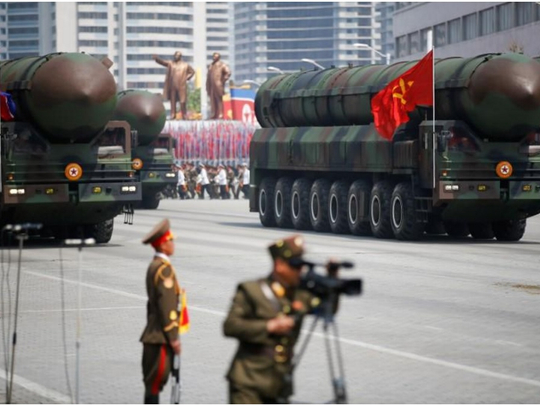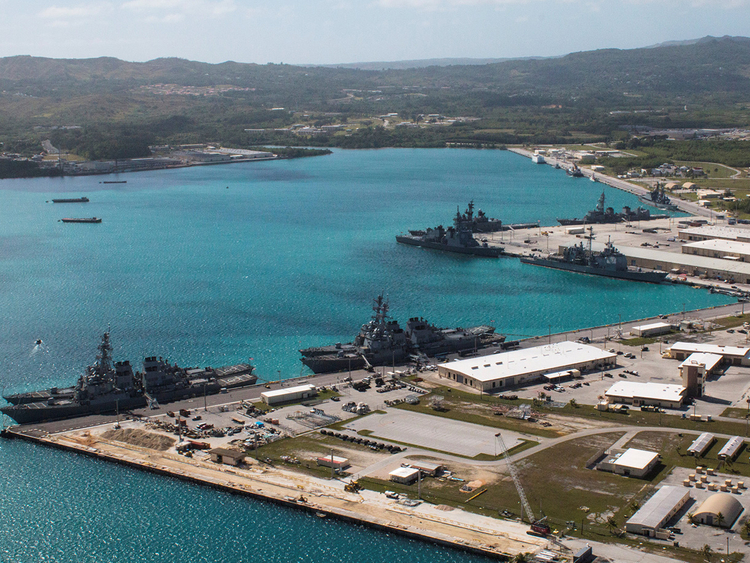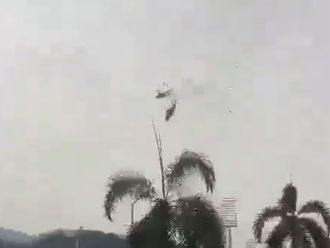
Guam, Berlin, Beijing: North Korea has announced a detailed plan to launch a salvo of ballistic missiles toward the US Pacific territory of Guam, a major military hub and home to US bombers.
If carried out, it would be the North's most provocative missile launch to date.
Here's a closer look at the least developments on the US-North Korea war of words.
The latest
President Donald Trump issued a new threat to North Korea on Friday, saying what he called US military solutions were "locked and loaded" as Pyongyang accused him of driving the Korean peninsula to the brink of nuclear war.
Russia, China and Germany expressed alarm at the escalating rhetoric from Pyongyang and Washington, while the Pentagon said the United States and South Korea would move ahead as planned with a joint military exercise in 10 days, an action sure to further antagonize North Korea.
Trump, vacationing at his Bedminster, New Jersey, golf resort, kept up the war of words on Twitter and again referenced North Korea's leader.
"Military solutions are now fully in place, locked and loaded, should North Korea act unwisely," he wrote.
"Hopefully Kim Jong Un will find another path!"
Locked and loaded
The term "locked and loaded," popularized in the 1949 war film "Sands of Iwo Jima" starring American actor John Wayne, refers to preparations for shooting a gun.
The Republican president's tweet came shortly after the North Korean state news agency, KCNA, put out a statement blaming him for the boiling tensions.
"Trump is driving the situation on the Korean peninsula to the brink of a nuclear war, making such outcries as 'the US will not rule out a war against the DPRK (North Korea),'" KCNA said.
A senior US diplomat has engaged in back-channel diplomacy with North Korea for several months, addressing the deteriorating relations, as well as the issue of Americans imprisoned in North Korea, the Associated Press reported.
The contacts are being held regularly between Joseph Yun, the US envoy for North Korea policy, and Pak Song Il, a senior North Korean diplomat at Pyongyang's UN mission, according to US officials and others briefed on the process cited by the AP.
The North Korean mission to the United Nations did not immediately respond to a Reuters request for comment.
'14 minutes to Guam'
Earlier, North Korea warned that they are finalising a plan to fire four Hwasong-12 missiles over Japan and would take about 14 minutes before it hits waters around Guam.
Japan and South Korea vowed a strong reaction if the North were to go through with the plan.
The North said the plan, which involves the missiles hitting waters 19 to 25 miles (30 to 40 kilometers) from the island, could be sent to leader Kim Jong Un for approval within a week or so.
It would be up to Kim whether the move is actually carried out.
President Donald Trump responded that perhaps his "fire and fury" warning "wasn't tough enough."
North Korea "better get their act together or they are going to be in trouble like few nations have ever been in trouble," the president told reporters while on vacation at his New Jersey golf club before a security briefing with top advisers.
German, Chinese reactions
German Chancellor Angela Merkel, meanwhile, has said she sees no military solution to North Korea crisis, and that escalating rhetoric "wrong answer".
China also called for cautious words and deeds over N.Korea on Friday. China's Foreign Ministry called on all sides to speak and act with caution, amid rising tensions between North Korea and the United States.
China hopes all sides can do more to help ease the present tense situation and increase mutual trust, rather than taking turns in shows of strength, the ministry said in a short statement on its website.
Russian reaction
Russian Foreign Minister Sergei Lavrov said on Friday the risks of a military conflict over North Korea's nuclear program are very high, and Moscow is deeply worried by the mutual threats being traded by Washington and Pyongyang.
"Unfortunately, the rhetoric in Washington and Pyongyang is now starting to go over the top," Lavrov said. "We still hope and believe that common sense will prevail."
Asked at a forum for Russian students about the risks of the stand-off escalating into armed conflict, he said: "The risks are very high, especially taking into account the rhetoric."
"Direct threats of using force are heard... The talk (in Washington) is that there must be a preventive strike made on North Korea, while Pyongyang is threatening to carry out a missile strike on the US base in Guam. These (threats) continue non-stop, and they worry us a lot."
"I won't get into guessing what happens 'if'. We will do whatever we can to prevent this 'if'."
"My personal opinion is that when you get close to the point of a fight breaking out, the side that is stronger and cleverer should take the first step away from the threshold of danger," said Lavrov, in remarks broadcast on state television.
Guam geography basics
The strip of land in the western Pacific Ocean is roughly the size of Chicago, and just 4 miles (6 km) wide at its narrowest point.
It is about 2,200 miles (3,500 km) southeast of North Korea, much closer than it is to any of the United States. Hawaii is about 4,000 miles (6,500 km) to the east.
Its proximity to China, Japan, the Philippines and the Korean Peninsula has long made the island an essential possession of the US military.
US relationship
Guam was claimed by Spain in 1565 and became a US territory in 1898 during the Spanish-American War. Japan seized it for about 2= years during World War II.
In 1950, an act of Congress made it an unincorporated organized territory of the United States.
It has limited self-government, with a popularly elected governor, small legislature, and non-voting delegate in the US House of Representatives. Residents do not pay US income taxes or vote in the general election for US president. Its natives are US citizens by birth.
Military history
The US keeps a Naval base and Coast Guard station in the south, and an Air Force base in the north that saw heavy use during the Vietnam War.
While already taking up 30 percent of the island, the American military has been seeking to increase its presence by relocating to Guam thousands of Marines who are currently based in Okinawa, Japan.
Protecting the island is the US Army's Terminal High Altitude Area Defense, or THAAD, which is used to shoot down ballistic missiles.
While there has been some resistance and displeasure from the people of Guam over the US military's presence, it is also essential to the island's economy, second only to tourism in importance.
People and government
The island was first populated about 4,000 years ago by the ancestors of the Chamorros, still the island's largest ethnic group. Now, about 160,000 people live on Guam.
Its capital city is Hagatna and its largest city is Dededo. Its chief languages are English and Chamorro.
It has seen various popular movements pushing for greater self-government or even US statehood, most notably a significant but failed effort in the 1980s to make it a commonwealth on par with Puerto Rico.
Military installations
There are two major bases on Guam: Andersen Air Force Base in the north and Naval Base Guam in the south.
They are both managed under Joint Base Marianas. The tourist district of Tumon, home to many of Guam's hotels and resorts, is in between. The air base was built in 1944, when the US was preparing to send bombers to Japan during World War II.
Today, Naval Base Guam is the home port for four nuclear-powered fast attack submarines and two submarine tenders.
Andersen Air Force Base hosts a Navy helicopter squadron and Air Force bombers that rotate to Guam from the US mainland. It has two 2-mile (3-kilometer) -long runways and large fuel and munitions storage facilities. Altogether, 7,000 US military personnel are stationed on Guam.
North Korean threat
The US military began rotating bombers - the B-2 stealth bomber as well as the B-1 and B-52 - to Andersen in 2004. It did so to compensate for US forces diverted from other bases in the Asia-Pacific region to fight in the Middle East.
The rotations also came as North Korea increasingly upped the ante in the standoff over its development of nuclear weapons.
In 2013, the Army sent a missile defense system to Guam called Terminal High Altitude Area Defense or THAAD.
It's designed to destroy ballistic missiles during their final phase of flight. A THAAD battery includes a truck-mounted launcher, tracking radar, interceptor missiles and an integrated fire control system.














